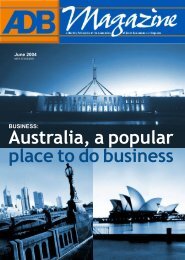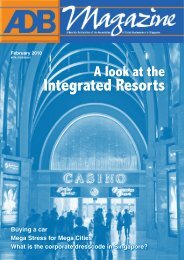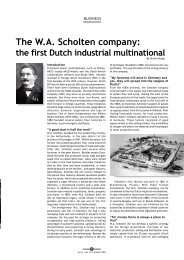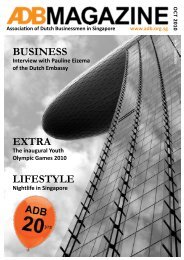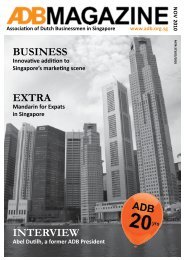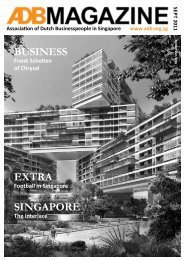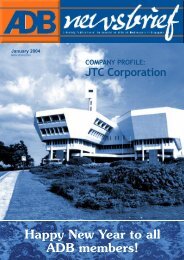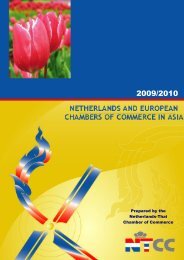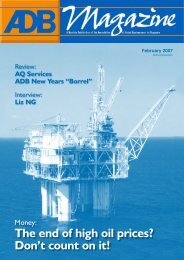June - July 2013 - Association of Dutch Businessmen
June - July 2013 - Association of Dutch Businessmen
June - July 2013 - Association of Dutch Businessmen
Create successful ePaper yourself
Turn your PDF publications into a flip-book with our unique Google optimized e-Paper software.
Events<br />
fusion. By combining Chinese and Western instruments<br />
and by recomposing scores from Western and Asian<br />
composers, SCO has created its own unique sound that is<br />
easy to relate to.<br />
When the sounds <strong>of</strong> SCO’s music faded, Mr Patrick<br />
Goh, the director <strong>of</strong> SCO, took the floor. He passionately<br />
explained that the Chinese Orchestra only has a 60 year<br />
history. Although Chinese music is at least 5,000 years old,<br />
it was mainly written for solo instruments. With the gradual<br />
opening up <strong>of</strong> China after World War II, composers started<br />
to put the solo instruments together in works for orchestras.<br />
Mr Goh also explained that it is very expensive to<br />
maintain an orchestra. The expenses are around $14 million<br />
per year. Currently, the SCO has 78 full time musicians. They<br />
perform in 110 concerts yearly. “But”, Mr Goh added, “The<br />
income from ticket sales is never enough to cover the costs.”<br />
In addition to the concerts, the musicians also perform in<br />
smaller groups at schools, hospitals and community centres.<br />
In this way they bring music to all people.<br />
Running a non-pr<strong>of</strong>it organisation<br />
The next item on the agenda was a presentation by<br />
Mr Terence Ho, who is the general manager <strong>of</strong> SCO. He<br />
manages 40 administrative staff and has 121 people on the<br />
pay-roll. Of the total expenditure <strong>of</strong> SCO, around 70% is<br />
covered by government grants.<br />
In the organisational structure, SCO looks more like<br />
a private company than a non-pr<strong>of</strong>it organisation. First<br />
<strong>of</strong> all, there is a board <strong>of</strong> directors, who are volunteers,<br />
appointed by the minister. They serve a 2 year term.<br />
The directors decide on the strategy for SCO, while the<br />
management team operates the orchestra. Supporting<br />
the management team is a large number <strong>of</strong> committees,<br />
such as the artistic committee, the audit committee, the<br />
finance committee, the human resource committee and<br />
the marketing & sponsorship committee.<br />
Mr Ho compared running a non-pr<strong>of</strong>it organisation with<br />
his favourite pastime, running. With an average mileage <strong>of</strong><br />
2,500km per year he is an expert runner. And as he said,<br />
“Running speeds you up, age slows you down”. So, you<br />
really have to keep running when you are managing a nonpr<strong>of</strong>it<br />
organisation.<br />
Next, Mr Ho introduced us to the dreams, inspiration,<br />
imagination and aspirations <strong>of</strong> SCO. Their aspirations<br />
cover 8 dimensions, which are audience, brand,<br />
employer, management, music, musicians, orchestra and<br />
place. These dimensions should work together to deliver<br />
the desired outcomes, which are artistic excellence and<br />
international stature; broader audience base and more<br />
sophisticated demand; organisational excellence and<br />
financial stability. And just like private companies, these<br />
desired outcomes are measured using key performance<br />
indicators, for example, number <strong>of</strong> commissioned and<br />
arranged works, number <strong>of</strong> ticketed performances,<br />
number <strong>of</strong> internships or earned income excluding<br />
grants.<br />
Panel discussion<br />
After this quick introduction to SCO we were given the<br />
opportunity to put all our burning questions to a panel,<br />
consisting <strong>of</strong> Mr Patrick Goh, Meastro Tsung Yeh (music<br />
director), Mr Terence Ho and Mr Ferry de Bakker.<br />
Where are the compositions sourced, given the short<br />
history <strong>of</strong> Chinese Orchestras?<br />
Of course, there is a lot <strong>of</strong> material from the 5,000 year<br />
long history <strong>of</strong> China. These scores are being used as a<br />
basis for compositions. There are a lot <strong>of</strong> composers from<br />
China, Taiwan, Hong Kong, Japan, Singapore and even<br />
the UK. Western composers are flown in to Singapore to<br />
learn about the Chinese instruments, so that they are<br />
able to include these instruments in their compositions.<br />
In addition to that, SCO has its own scores library, which<br />
contains more than 8,000 pieces. Local Chinese orchestras<br />
(more than 200!) source from this library.<br />
What percentage <strong>of</strong> the musicians are locals?<br />
Most <strong>of</strong> the musicians are Singaporean or naturalised<br />
Singaporean, just a small percentage have a work pass or<br />
are permanent residents.<br />
Where do you source your musicians?<br />
In Singapore Chinese instruments are very popular. The<br />
huge number <strong>of</strong> local orchestras provides an enormous<br />
source <strong>of</strong> talented musicians. For auditions, SCO normally<br />
attracts three to four hundred candidates. SCO also<br />
operates the Singapore Chinese Youth Orchestra (SCYO),<br />
which currently consists <strong>of</strong> 98 musicians.<br />
6



